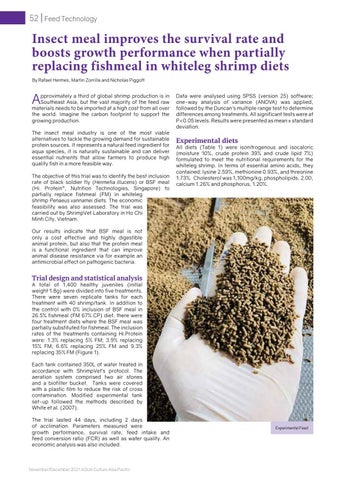52 Feed Technology
Insect meal improves the survival rate and boosts growth performance when partially replacing fishmeal in whiteleg shrimp diets By Rafael Hermes, Martin Zorrilla and Nicholas Piggott
A
pproximately a third of global shrimp production is in Southeast Asia, but the vast majority of the feed raw materials needs to be imported at a high cost from all over the world. Imagine the carbon footprint to support the growing production. The insect meal industry is one of the most viable alternatives to tackle the growing demand for sustainable protein sources. It represents a natural feed ingredient for aqua species, it is naturally sustainable and can deliver essential nutrients that allow farmers to produce high quality fish in a more feasible way.
The objective of this trial was to identify the best inclusion rate of black soldier fly (Hermetia illucens) or BSF meal (Hi. Protein®, Nutrition Technologies, Singapore) to partially replace fishmeal (FM) in whiteleg shrimp Penaeus vannamei diets. The economic feasibility was also assessed. The trial was carried out by ShrimpVet Laboratory in Ho Chi Minh City, Vietnam.
Data were analysed using SPSS (version 25) software; one-way analysis of variance (ANOVA) was applied, followed by the Duncan’s multiple range test to determine differences among treatments. All significant tests were at P<0.05 levels. Results were presented as mean ± standard deviation.
Experimental diets
All diets (Table 1) were isonitrogenous and isocaloric (moisture 10%, crude protein 39% and crude lipid 7%) formulated to meet the nutritional requirements for the whiteleg shrimp. In terms of essential amino acids, they contained: lysine 2.59%, methionine 0.93%, and threonine 1.73%. Cholesterol was 1,100mg/kg, phospholipids, 2.00, calcium 1.26% and phosphorus, 1.20%.
Our results indicate that BSF meal is not only a cost effective and highly digestible animal protein, but also that the protein meal is a functional ingredient that can improve animal disease resistance via for example an antimicrobial effect on pathogenic bacteria.
Trial design and statistical analysis
A total of 1,400 healthy juveniles (initial weight 1.8g) were divided into five treatments. There were seven replicate tanks for each treatment with 40 shrimp/tank. In addition to the control with 0% inclusion of BSF meal in 26.5% fishmeal (FM 67% CP) diet, there were four treatment diets where the BSF meal was partially substituted for fishmeal. The inclusion rates of the treatments containing Hi.Protein were: 1.3% replacing 5% FM; 3.9% replacing 15% FM; 6.6% replacing 25% FM and 9.3% replacing 35% FM (Figure 1). Each tank contained 350L of water treated in accordance with ShrimpVet’s protocol. The aeration system comprised two air stones and a biofilter bucket. Tanks were covered with a plastic film to reduce the risk of cross contamination. Modified experimental tank set-up followed the methods described by White et al. (2007). The trial lasted 44 days, including 2 days of acclimation. Parameters measured were growth performance, survival rate, feed intake and feed conversion ratio (FCR) as well as water quality. An economic analysis was also included.
November/December 2021 AQUA Culture Asia Pacific
Experimental Feed












